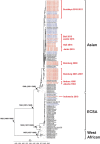Chikungunya virus infection in Indonesia: a systematic review and evolutionary analysis
- PMID: 30866835
- PMCID: PMC6417237
- DOI: 10.1186/s12879-019-3857-y
Chikungunya virus infection in Indonesia: a systematic review and evolutionary analysis
Abstract
Background: Despite the high number of chikungunya cases in Indonesia in recent years, comprehensive epidemiological data are lacking. The systematic review was undertaken to provide data on incidence, the seroprevalence of anti-Chikungunya virus (CHIKV) IgM and IgG antibodies, mortality, the genotypes of circulating CHIKV and travel-related cases of chikungunya in the country. In addition, a phylogenetic and evolutionary analysis of Indonesian CHIKV was conducted.
Methods: A systematic review was conducted to identify eligible studies from EMBASE, MEDLINE, PubMed and Web of Science as of October 16th 2017. Studies describing the incidence, seroprevalence of IgM and IgG, mortality, genotypes and travel-associated chikungunya were systematically reviewed. The maximum likelihood phylogenetic and evolutionary rate was estimated using Randomized Axelerated Maximum Likelihood (RAxML), and the Bayesian Markov chain Monte Carlo (MCMC) method identified the Time to Most Recent Common Ancestors (TMRCA) of Indonesian CHIKV. The systematic review was registered in the PROSPERO database (CRD42017078205).
Results: Chikungunya incidence ranged between 0.16-36.2 cases per 100,000 person-year. Overall, the median seroprevalence of anti-CHIKV IgM antibodies in both outbreak and non-outbreak scenarios was 13.3% (17.7 and 7.3% for outbreak and non-outbreak events, respectively). The median seroprevalence of IgG antibodies in both outbreak and non-outbreak settings was 18.5% (range 0.0-73.1%). There were 130 Indonesian CHIKV sequences available, of which 120 (92.3%) were of the Asian genotype and 10 (7.7%) belonged to the East/Central/South African (ECSA) genotype. The ECSA genotype was first isolated in Indonesia in 2008 and was continually sampled until 2011. All ECSA viruses sampled in Indonesia appear to be closely related to viruses that caused massive outbreaks in Southeast Asia countries during the same period. Massive nationwide chikungunya outbreaks in Indonesia were reported during 2009-2010 with a total of 137,655 cases. Our spatio-temporal, phylogenetic and evolutionary data suggest that these outbreaks were likely associated with the introduction of the ECSA genotype of CHIKV to Indonesia.
Conclusions: Although no deaths have been recorded, the seroprevalence of anti-CHIKV IgM and IgG in the Indonesian population have been relatively high in recent years following re-emergence in early 2001. There is sufficient evidence to suggest that the introduction of ECSA into Indonesia was likely associated with massive chikungunya outbreaks during 2009-2010.
Keywords: Chikungunya; Chikungunya virus; ECSA genotype; Indonesia; Systematic review.
Conflict of interest statement
Ethics approval and consent to participate
Not applicable.
Consent for publication
Not applicable.
Competing interests
The authors declare that they have no competing interests.
Publisher’s Note
Springer Nature remains neutral with regard to jurisdictional claims in published maps and institutional affiliations.
Figures





References
-
- Shragai T, Tesla B, Murdock C, Harrington LC. Zika and chikungunya: mosquito-borne viruses in a changing world. Ann N Y Acad Sci. 2017;1399(1):61–77. - PubMed
-
- Schwartz O, Albert ML. Biology and pathogenesis of chikungunya virus. Nat Rev Microbiol. 2010;8(7):491–500. - PubMed
-
- Burt FJ, Chen W, Miner JJ, Lenschow DJ, Merits A, Schnettler E, Kohl A, Rudd PA, Taylor A, Herrero LJ, et al. Chikungunya virus: An update on the biology and pathogenesis of this emerging pathogen. Lancet Infect Dis. 2017;17(4):e107–e117. - PubMed
-
- Robinson MC. An epidemic of virus disease in Southern Province, Tanganyika territory, in 1952-53. I. Clinical features. Trans R Soc Trop Med Hyg. 1955;49(1):28–32. - PubMed
Publication types
MeSH terms
Grants and funding
LinkOut - more resources
Full Text Sources
Medical

